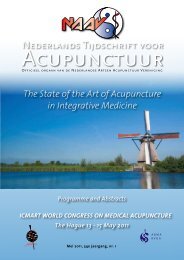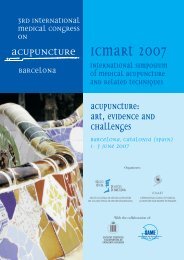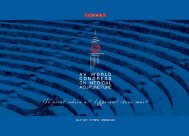Congress Abstracts full PDF - International Council of Medical ...
Congress Abstracts full PDF - International Council of Medical ...
Congress Abstracts full PDF - International Council of Medical ...
You also want an ePaper? Increase the reach of your titles
YUMPU automatically turns print PDFs into web optimized ePapers that Google loves.
THERMAL CHARACTERISTICS OF MOXABUSTION AS A FUNCTION OF AIR FLOW<br />
Seung-Ho Yi, Hye-Jung Lee, Hi-Joon Park<br />
In traditional Chinese medicine, moxibustion is one <strong>of</strong> main therapeutic tools by delivering heat to specific areas<br />
like meridian points. Heat stimulation by a moxa could be achieved by controlling the physical dimension <strong>of</strong> the moxa<br />
such as mass, shape and density. It also depends on the existence <strong>of</strong> buffer layers such as ginger and air. A chemical<br />
property <strong>of</strong> moxa itself is alleged to relate the efficacy <strong>of</strong> moxibustion.<br />
In order to be effective, the dynamics <strong>of</strong> moxibustion varies with symptoms.<br />
Practically, controlling temperature or heat amount <strong>of</strong> moxibustion as a function <strong>of</strong> time is not easy in hospital, which<br />
might cause inconsistency <strong>of</strong> moxibustion treatment.<br />
In this study, we measured temperature variation <strong>of</strong> moxibustion with various air low. Our data showed that<br />
maximum temperature obtained from each moxibustion was increased with the flow. But there was a local maximum<br />
<strong>of</strong> the temperature at a certain air flow, meaning that the maximum temperature and air flow was not linearly related.<br />
Duration time <strong>of</strong> moxibustion also demonstrated similar trends.<br />
Our study emphasized that air flow is one <strong>of</strong> the essential parameters to control temperature <strong>of</strong> moxibustion and,<br />
in turn, to make moxibustion effective.<br />
This work was supported by the Korea Science and Engineering Foundation (KOSEF) grant funded by the Korea<br />
government (MEST) (R11-2005-014).<br />
EFFECT AND MECHANISM OF MOXIBUSTION ON ACUPOINTS ZUSANLI (ST 36) AND LIANGMEN (ST 21)<br />
IN THE PREVENTION AND TREATMENT OF STRESS ULCER<br />
Shou-Xiang Yi, Yan Peng, Xiao-Rong Chang, Na Peng, Jie Yan, Ya-Ping Lin<br />
Hunan Uiversity <strong>of</strong> Traditional Chinese Medicine, Changsha China<br />
Objective: To observe the effect <strong>of</strong> moxibustion on acupoints Zusanli (ST 36) and Liangmen (ST 31) on cell<br />
proliferation and cell apoptosis <strong>of</strong> gastric mucosa in rats with stress ulcer, investigatethe mechanism <strong>of</strong> moxibustion<br />
in promoting the repair <strong>of</strong> gastric mucosal injury at cellular and molecular levels.<br />
Methods: Sixty healthy Sprague-Dawley rats were randomly divided into four groups: the restraint control group,<br />
model group, moxibustion on acupoints group and moxibustion on non-acupoints group. Water immersion and<br />
restraint stress (WRS) was used to copy the stress ulcer model <strong>of</strong> rats, radio-immunoassay was used to detect the<br />
content <strong>of</strong> transforming growth factor (TGF-±), and S-P immunohistochemical assay was adopted to determine the<br />
HSP70 expression, the proliferating cell nuclear antigen (PCNA) and cell apoptosis index in gastric mucosa.<br />
Results: For the WRS-induced gastric ulcer model <strong>of</strong> rat, the gastric mucosal injury (gastric ulcer index, UI) was<br />
increased, the content <strong>of</strong> TGF-± was decreased, PCNA was also decreased, HSP70 expression and cell apoptosis<br />
index were all increased (P







